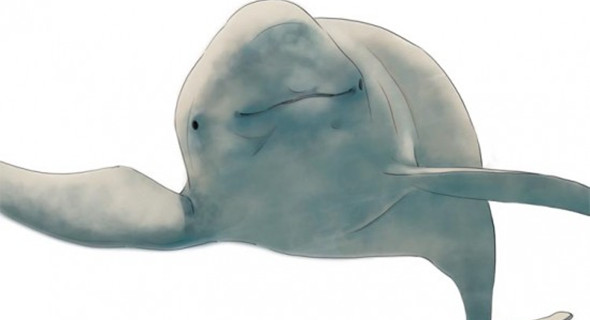

It was a comment simply stunning in its ignorance: in July, 2013, Wang Ding, a hydrobiology professor, was carefully explaining to a local official about the need to protect the finless porpoise of the Yangtze River. The official asked, "Is the river porpoise delicious?" Wang Ding was dumbfounded, replying, "No." "Then why are we protecting it?" A video of this exchange was shown on CCTV, and ultimately the official's callous gaffe—if nothing else—helped raise awareness of the importance of protecting this vulnerable fresh water cetacean. The Yangtze fin less porpoise is one of two species of freshwater dolphin living in the Yangtze River. Another Yangtze dolphin, the famous baiji, was declared functionally extinct in 2007. Compared to other species of dolphin, the fin less porpoise is small in size, doesn't have a dorsal fin, has a stunted forehead, and a smile permanently cracks across its face. In some Chinese dialects it's called "the river pig" (江猪子).
"Its intelligence is equal to that of a four- or five-year-old human child. It is timid, alert to any disturbances, but also vibrant and inquisitive of unknown things," says Wang Chaoqun, keeper of fin less porpoises in the aquarium of the Institute of Hydrobiology, Chinese Academy of Sciences.
The Yangtze fin less porpoise's ancestors first entered the Yangtze River about a million years ago, and the mammal lived undisturbed there until the late 1970s, when the Reform and Opening Up turned the river into a bustling "golden passage". In just three short decades, human activity completely altered the fin less porpoise's habitat, and the species is being pushed to extinction at an alarming rate. Every year, large numbers of the finless porpoises die due to electro-fishing, injuries caused by ships and fishing tools, water pollution, and even starvation. In 2006, the population of the fin less porpoises was 1,800; in just six years the number dropped to 1,040, a yearly decline of 13.7 percent.At this rate, the species will be extinct in 10 to 15 years.
Long run to be held to save finless porpoise
2013-11-14Fish ecosystem on Yangtze 'on verge of collapse'
2013-08-16Copyright ©1999-2018
Chinanews.com. All rights reserved.
Reproduction in whole or in part without permission is prohibited.